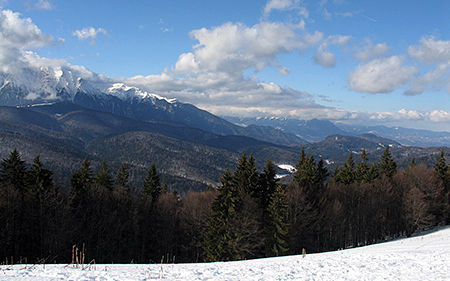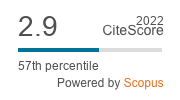Geometric approaches to computing 3D-landscape metrics
DOI:
https://doi.org/10.3097/LO.201024Keywords:
3D-analysis, Landscape metrics, Patch-corridor-matrix model, Relief, TriangulationAbstract
The relationships between patterns and processes lie at the core of modern landscape ecology. These dependences can be quantified by using indices related to the patch-corridor-matrix model. This model conceptualizes landscapes as planar mosaics consisting of discrete patches. On the other hand, relief variability is a key factor for many ecological processes, and therefore these processes can be better modeled by integrating information concerning the third dimension of landscapes. This can be done by generating a triangle mesh which approximates the original terrain. The aim of this methodological paper is to introduce two new constructions of triangulations which replace a digital elevation model. These approximation methods are compared with the method which was already used in the computation of 3D-landscape metrics (firstly for parameterized surfaces and secondly for two landscape mosaics). The statistical analysis shows that all three methods are of almost equal sensitivity in reflecting the relationship between terrain ruggedness and the patches areas and perimeters. In particular, either of the methods can be used for approximating the real values of these basic metrics. However, the two methods introduced in this paper have the advantage of yielding continuous approximations of the terrain, and this fact could be useful for further developments.
References
Adriaensen, F., Chardon, J. P., De Blust, G., Swinnen, E., Villalba, S., Gulinck, H., & Matthysen, E. (2003). The application of 'least-cost' modelling as a functional landscape model. Landscape and Urban Planning, 64(4), 233-247. doi:10.1016/S0169-2046(02)00242-6
Allison, J. D., Borden, J. H., & Seybold, S. J. (2004). A review of the chemical ecology of the cerambycidae (coleoptera). Chemoecology, 14(3-4), 123-150. doi:10.1007/s00049-004-0277-1
Bélisle, M. (2005). Measuring landscape connectivity: The challenge of behavioral landscape ecology. Ecology, 86(8), 1988-1995. doi:10.1890/04-0923
Bender, D. J., & Fahrig, L. (2005). Matrix structure obscures the relationship between interpatch movement and patch size and isolation. Ecology, 86(4), 1023-1033. doi:10.1890/03-0769
Bergin, T. M., Best, L. B., Freemark, K. E., & Koehler, K. J. (2000). Effects of landscape structure on nest predation in roadsides of a midwestern agroecosystem: A multiscale analysis. Landscape Ecology, 15(2), 131-143. doi:10.1023/A:1008112825655
Blackman, M. W. (1918).
Brattli, J. G., Andersen, J., & Nilssen, A. C. (1998). Primary attraction and host tree selection in deciduous and conifer living coleoptera: Scolytidae, curculionidae, cerambycidae and lymexylidae. Journal of Applied Entomology, 122(7), 345-352. doi:10.1111/j.1439-0418.1998.tb01511.x
Chénier, J. V. R., & Philogéne, B. J. R. (1989). Evaluation of three trap designs for the capture of conifer-feeding beetles and other forest coleoptera. The Canadian Entomologist, 121(2), 159-167. doi:10.4039/Ent121159-2
Chénier, J. V. R., & Philogène, B. J. R. (1989). Field responses of certain forest coleoptera to conifer monoterpenes and ethanol. Journal of Chemical Ecology, 15(6), 1729-1745. doi:10.1007/BF01012261
Collinge, S. K., & Palmer, T. M. (2002). The influences of patch shape and boundary contrast on insect response to fragmentation in california grasslands. Landscape Ecology, 17(7), 647-656. doi:10.1023/A:1021536302195
Craighead, F. C. (1950). Insect enemies of eastern forests. Miscellaneous Publications, United States Department of Agriculture, 657, 1-679.
Deam, C. C. (1931). Trees of indiana. fort wayne printing co., fort wayne. (ESRI) environmental systems research institute, inc. 2005. ArcGIS Desktop Help, Release 9.1.Environmental Systems Research Institute, Inc., Redlands,
Farrer, J. L. (1995). Trees of the northern united states and canada. iowa state university press, ames. Federal Emergency Management Agency 2006 (FEMA).FEMA Flood Zones,
Foley, C. J. (2008).
Hanks, L. M. (1996). Body size influences mating success of the eucalyptus longhorned borer (coleoptera: Cerambycidae). Journal of Insect Behavior, 9(3), 369-382. doi:10.1007/BF02214016
Hanks, L. M. (1999). Influence of the larval host plant on reproductive strategies of cerambycid beetles doi:10.1146/annurev.ento.44.1.483
Hanks, L. M., Millar, J. C., & Paine, T. D. (1995). Biological constraints on host-range expansion by the wood-boring beetle phoracantha semipunctata (coleoptera: Cerambycidae). Annals of the Entomological Society of America, 88(2), 183-188. doi:10.1093/aesa/88.2.183
Hanks, L. M., Millar, J. G., & Paine, T. D. (1998). Dispersal of the eucalyptus longhorned borer (coleoptera: Cerambycidae) in urban landscapes. Environmental Entomology, 27(6), 1418-1424. doi:10.1093/ee/27.6.1418
Hanski, I. (1994). A practical model of metapopulation dynamics. Journal of Animal Ecology, 63(1), 151-162. doi:10.2307/5591
Hanula, J. L. (1993). Relationship of wood-feeding insects and coarse woody debris. in: J.W. McMinn & J.D.A. crossley (eds.): Workshop on the coarse woody debris in southern forests: Effects on biodiversity. USDA Forest Service, Athens,
Holland, J. D., Bert, D. G., & Fahrig, L. (2004). Determining the spatial scale of species' response to habitat. Bioscience, 54(3), 227-233. doi:10.1641/0006-3568(2004)054[0227:DTSSOS]2.0.CO;2
Hunter, M. D. (2002). Landscape structure, habitat fragmentation, and the ecology of insects. Agricultural and Forest Entomology, 4(3), 159-166. doi:10.1046/j.1461-9563.2002.00152.x
Hurvich, C. M., & Tsai, C. L. (1989). Regression and time series model selection in small samples. Biometrika, 76(2), 297-307. doi:10.1093/biomet/76.2.297
Jia, G. J., Burke, I. C., Goetz, A. F. H., Kaufmann, M. R., & Kindel, B. C. (2006). Assessing spatial patterns of forest fuel using AVIRIS data. Remote Sensing of Environment, 102(3-4), 318-327. doi:10.1016/j.rse.2006.02.025
Jopp, F., & Reuter, H. (2005). Dispersal of carabid beetles - emergence of distribution patterns. Ecological Modelling, 186(4), 389-405. doi:10.1016/j.ecolmodel.2005.02.009
Knull, J. N. (1946). The long-horned beetles of ohio (coleoptera: Cerambycidae). Bulletin of the Ohio Biological Survey, 39(4), 133-354.
Kotinsky, J. (1921).
Lacey, E. S., Ginzel, M. D., Millar, J. G., & Hanks, L. M. (2004). Male-produced aggregation pheromone of the cerambycid beetle neoclytus acuminatus acuminatus. Journal of Chemical Ecology, 30(8), 1493-1507. doi:10.1023/B:JOEC.0000042064.25363.42
Linsley, E. G. (1959). Ecology of cerambycidae. Annual Review of Entomology, 4, 99-138.
Linsley, E. G., & Chemsak, J. A. (1997).
Mattson, W., Vanhanen, H., Veteli, T., Sivonen, S., & Niemelä, P. (2007). Few immigrant phytophagous insects on woody plants in europe: Legacy of the european crucible? Biological Invasions, 9(8), 957-974. doi:10.1007/s10530-007-9096-y
Mazerolle, M. J. (2004).
Merriam, G. (1984). Connectivity: A fundamental ecological characteristic of landscape pattern. Methodology in Landscape Ecological Research and Planning, , 5-15.
Ray, N., Lehmann, A., & Joly, P. (2002). Modeling spatial distribution of amphibian populations: A GIS approach based on habitat matrix permeability. Biodiversity and Conservation, 11(12), 2143-2165. doi:10.1023/A:1021390527698
Roland, J., & Taylor, P. D. (1997). Insect parasitoid species respond to forest structure at different spatial scales. Nature, 386(6626), 710-713. doi:10.1038/386710a0
Roques, A. (2007).
Singleton, P. H., Gaines, W. L., & Lehmkuhl, J. F. (2004). Landscape permeability for grizzly bear movements in washington and southwestern british columbia. Ursus, 15(1), 90-103. doi:10.2192/1537-6176(2004)015<0090:LPFGBM>2.0.CO;2
Solomon, J. D. (1995).
Sork, V. L. (1983). Distribution of pignut hickory ( carya glabra) along a forest to edge transect, and factors affecting seedling recruitment. Bulletin - Torrey Botanical Club, 110(4), 494-506. doi:10.2307/2996284
Steffan-Dewenter, I., Münzenberg, U., Bürger, C., Thies, C., & Tscharntke, T. (2002). Scale-dependent effects of landscape context on three pollinator guilds. Ecology, 83(5), 1421-1432. doi:10.1890/0012-9658(2002)083[1421:SDEOLC]2.0.CO;2
Stevens, V. M., Verkenne, C., Vandewoestijne, S., Wesselingh, R. A., & Baguette, M. (2006). Gene flow and functional connectivity in the natterjack toad. Molecular Ecology, 15(9), 2333-2344. doi:10.1111/j.1365-294X.2006.02936.x
Sutcliffe, O. L., Bakkestuen, V., Fry, G., & Stabbetorp, O. E. (2003). Modelling the benefits of farmland restoration: Methodology and application to butterfly movement. Landscape and Urban Planning, 63(1), 15-31. doi:10.1016/S0169-2046(02)00153-6
Swihart, R. K., Goheen, J. R., Schnelker, S. A., & Rizkalla, C. E. (2007). Testing the generality of patch and landscape-level predictors of tree squirrel occurrence at a regional scale. Journal of Mammalogy, 88(3), 564-572. doi:10.1644/06-MAMM-A-275R.1
Taylor, P. D., Fahrig, L., Henein, K., & Merriam, G. (1993). Connectivity is a vital element of landscape structure. Oikos, 68(3), 571-573. doi:10.2307/3544927
Tirmenstein, D. A. (1991).
Verbeylen, G., De Bruyn, L., Adriaensen, F., & Matthysen, E. (2003). Does matrix resistance influence red squirrel (sciurus vulgaris L. 1758) distribution in an urban landscape? Landscape Ecology, 18(8), 791-805. doi:10.1023/B:LAND.0000014492.50765.05
Vogelmann, J. E., Howard, S. M., Yang, L., Larson, C. R., Wylie, B. K., & Van Driel, N. (2001).
Wagenmakers, E. -., & Farrell, S. (2004). AIC model selection using akaike weights. Psychonomic Bulletin and Review, 11(1), 192-196. doi:10.3758/BF03206482
Waters, D. J. (1981). Life history of neoclytus acuminatus with notes on other cerambycids associated with dead or dying deciduous trees. MS Thesis.Auburn University, Auburn,

Downloads
Published
How to Cite
Issue
Section
License
Copyright (c) 2019 Mihai Sorin Stupariu, Ileana Georgeta Pàtru-Stupariu, Roxana Cuculici

This work is licensed under a Creative Commons Attribution 4.0 International License.










